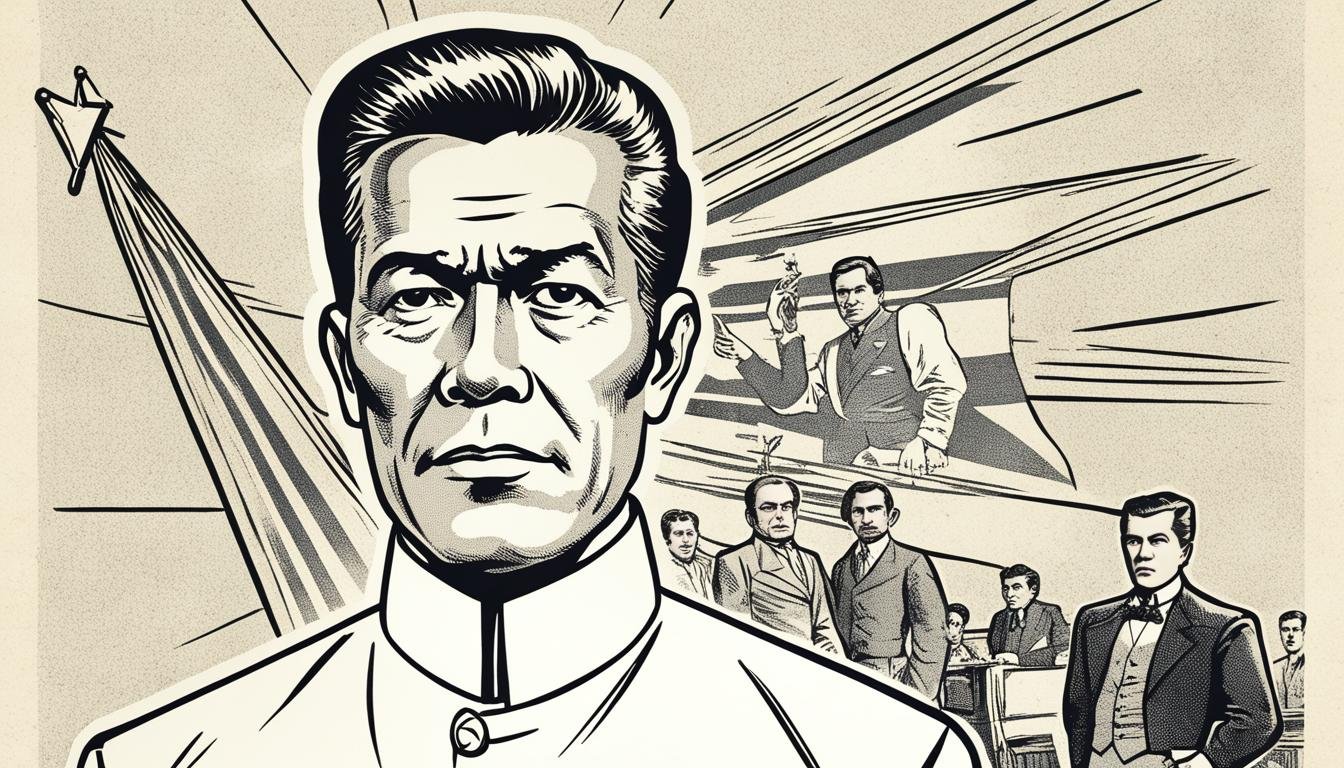Aguinaldo’s leadership and enduring legacy make him a key figure in Philippine history, and his story is one that captivates and inspires. From his early years and political ascent to his establishment of the First Philippine Republic and the tumultuous years that followed, Aguinaldo’s life was intertwined with the nation’s struggle for freedom.
In this article, we will delve into the remarkable life of Emilio Aguinaldo, exploring his early years, political endeavors, presidency, and his complex legacy. Join us on this journey as we uncover the story of a man who played a pivotal role in shaping the history of the Philippines.
Key Takeaways:
- Emilio Aguinaldo was the first president of the Philippines and lived for nearly a century from 1869 to 1964.
- He played a pivotal role in the country’s fight for independence from Spanish rule.
- Aguinaldo’s life was marked by his early political ascent, the establishment of the First Philippine Republic, and his subsequent role in the Philippine-American War.
- Controversies surrounding Aguinaldo’s actions and decisions shape his complex legacy, leading to ongoing discussions and debates among scholars and historians.
- Despite these controversies, Aguinaldo’s contributions to the nationalist movement and the fight for Philippine independence remain significant.
Early Years and Political Ascent
Emilio Aguinaldo, the first President of the Philippines, was born on March 22, 1869, in Cavite el Viejo, Cavite, Philippines. He came from a well-to-do family, with his father Carlos Aguinaldo serving as the gobernadorcillo (municipal governor) of their community.
Aguinaldo began his education at Colegio de San Juan de Letran. However, his studies were interrupted by a cholera outbreak in 1882, preventing him from completing his education. Despite this setback, he acquired valuable experience in local government as a cabeza de barangay and later became Cavite el Viejo’s first gobernadorcillo capitan municipal.
In 1895, Aguinaldo joined the secret society Katipunan, which advocated for Philippine independence from Spanish rule. With his dedication and leadership, Aguinaldo quickly rose through the ranks and became a prominent figure in the organization, assuming the name Magdalo.
Aguinaldo’s early years and political ascent laid the foundation for his future endeavors in the fight for Philippine independence. His upbringing in a politically active family and his involvement in Katipunan showcased his commitment to the cause, setting the stage for the pivotal role he would play in shaping the nation’s history.
Emilio Aguinaldo’s Leadership in the Philippine Revolution
Emilio Aguinaldo played a crucial role in the Philippine Revolution, actively leading the fight for independence against Spanish rule. His participation in the revolution was marked by his membership in the Freemasonry, a secret society that advocated for Philippine independence from Spain. Aguinaldo joined the Freemasonry in 1895, and this affiliation played a significant role in his fight for freedom.
Aguinaldo worked alongside other revolutionary leaders, including the renowned Andrés Bonifacio, in a united front against Spanish oppression. Together, they strategized and coordinated their efforts to challenge Spanish rule and achieve independence.
In their fight for independence, Aguinaldo and his troops employed various tactics and strategies, including guerrilla warfare. They engaged in carefully planned battles that showcased their military prowess and temporarily drove the Spanish forces out of Cavite, a significant achievement in the revolution.
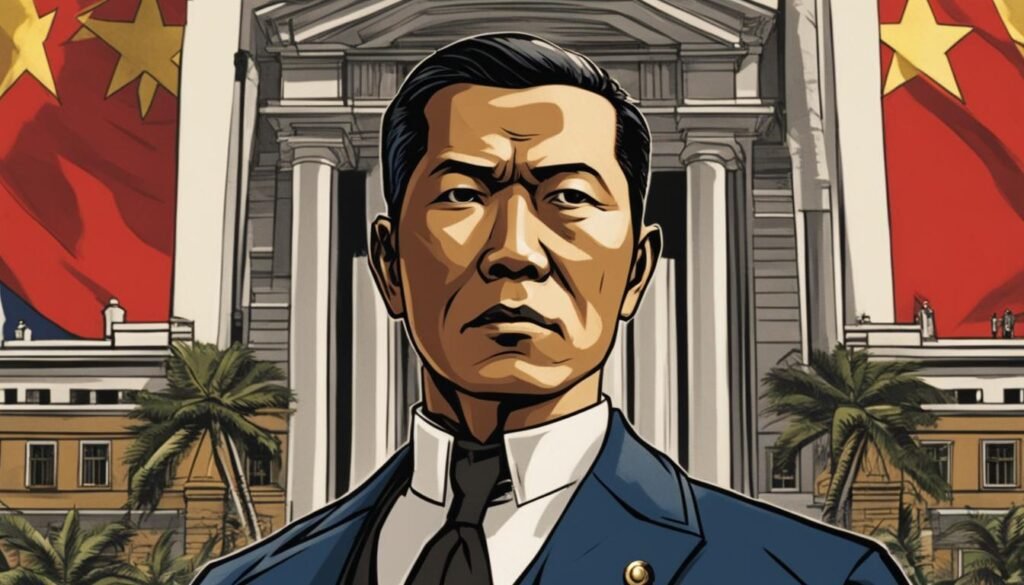
The Establishment of the First Philippine Republic
On June 12, 1898, Emilio Aguinaldo made a historic declaration, proclaiming the independence of the Philippines and establishing the First Philippine Republic. This significant event marked a pivotal moment in the country’s history and the culmination of years of struggle against Spanish colonial rule.
The newly established republic’s capital was set in Malolos, Bulacan, where Aguinaldo assumed the role of its president. With this declaration, the Filipino people finally had a sovereign government to lead them towards a future of freedom and self-determination.
Aguinaldo’s Presidency and the Philippine-American War
Aguinaldo’s presidency was marked by the drafting and adoption of the Malolos Republic Constitution. This constitution established a democratic government and outlined the rights and responsibilities of the Filipino people.
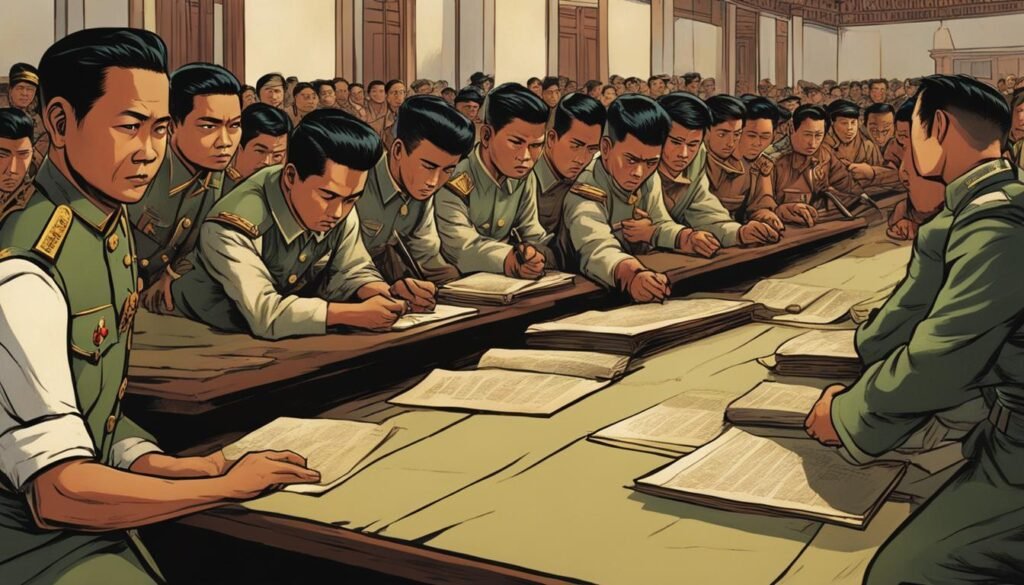
Despite their declaration of independence, the Philippines soon found themselves in conflict with the United States. The tension escalated, leading to the outbreak of the Philippine-American War in 1899.
Life in Exile: Aguinaldo’s Temporary Retreat
Aguinaldo’s journey for Philippine independence faced a series of military setbacks. In an attempt to regroup and strategize, he entered into the Pact of Biac-na-Bató with the Spanish government. This agreement allowed Aguinaldo to go into exile in Hong Kong in exchange for financial compensation. The temporary retreat to Hong Kong provided him with time to recover and plan his next moves.
The Pact of Biac-na-Bató and the Move to Hong Kong
The Pact of Biac-na-Bató represented a significant turning point in Aguinaldo’s fight for independence. It provided him with a respite from the intense military conflict and allowed him to assess his resources and options. The agreement gave Aguinaldo the opportunity to seek financial compensation, which would later play a crucial role in his return to the Philippines.
Return to the Philippines and Renewed Conflict
Following his temporary exile, Aguinaldo returned to the Philippines in 1898, determined to resume his fight for independence. He collaborated with the United States during the Spanish-American War, hoping to gain American support for the cause of Philippine independence. Aguinaldo’s return marked a renewed period of conflict and struggle as he sought to rally Filipino forces and challenge Spanish rule once again.
A Tumultuous Tenure: Strategic Battles and Military Governance
Throughout his tenure, Aguinaldo faced numerous challenges and engaged in strategic battles to protect the sovereignty of the Philippines. He implemented military governance to maintain order and stability during this tumultuous period.
Aguinaldo’s commitment to protecting the Philippines from external threats led him to strategically plan and execute battles against opposing forces. His military leadership and strategic decision-making played a crucial role in defending the nation’s sovereignty.
To ensure order and stability within the Philippines, Aguinaldo established military governance. This system allowed for efficient organization and coordination of resources, enabling the defense of key territories and strategic points.
Under Aguinaldo’s military governance, law and order were maintained, providing a sense of stability amid the turmoil of the revolution. This allowed the government to continue functioning and serving the needs of the Filipino people.
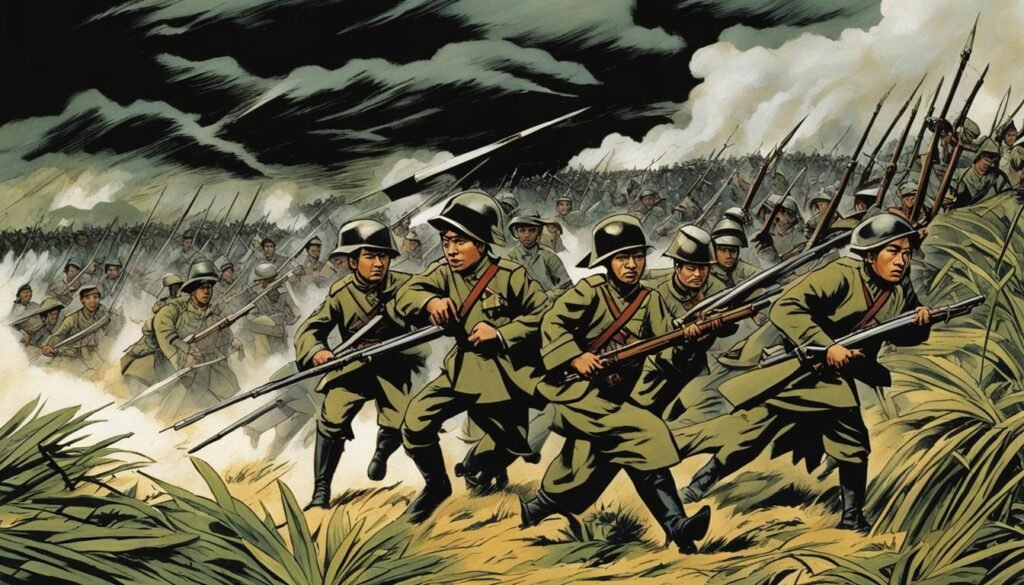
| Battles | Significance |
|---|---|
| Battle of Alapan | Symbolic victory to commemorate the first unfurling of the Philippine flag |
| Battle of Imus | Retaking of Imus, a strategic location in Cavite |
| Battle of Zapote River | Defeat of Spanish forces, securing Cavite for the revolutionaries |
| Battle of Tirad Pass | Aguinaldo’s last stand against American forces, resulting in his capture |
These strategic battles played a pivotal role in protecting the sovereignty of the Philippines and advancing the cause of independence. Aguinaldo’s military leadership and governance set the foundation for the future development of the nation.
The Capture of Aguinaldo and the End of Military Resistance
In 1901, Aguinaldo was captured by American forces, marking a turning point in the Philippine resistance. His capture dealt a significant blow to the armed resistance against American occupation.
The Turning Point in Philippine Resistance
The capture of Aguinaldo was a pivotal moment in the struggle for Philippine independence. It signaled a shift in power and strategy, as the American forces gained the upper hand in suppressing the resistance movement. Aguinaldo’s capture weakened the armed resistance and hindered the Filipino forces’ ability to wage a full-scale war against the American occupation.
Pledge of Allegiance to the United States
After his capture, Aguinaldo took an oath of allegiance to the United States, signaling his acceptance of American rule. This decision was met with mixed reactions from the Filipino people, as some saw it as a pragmatic choice to ensure the welfare of the Philippines, while others viewed it as a betrayal of the fight for independence.
Despite his pledge of allegiance, Aguinaldo retired from public life and received a pension from the U.S. government. His capture and subsequent actions marked the end of the military resistance against American occupation and set the stage for a new chapter in Philippine history.
Emilio Aguinaldo’s Political Involvement Post-War
After the war, Aguinaldo remained politically silent for several years. He dedicated his time to personal endeavors and focused on veterans’ affairs. However, Aguinaldo’s political aspirations were far from over. He would go on to play a new role during the Commonwealth Era, serving as a member of the Council of State appointed by President Elpidio Quirino.
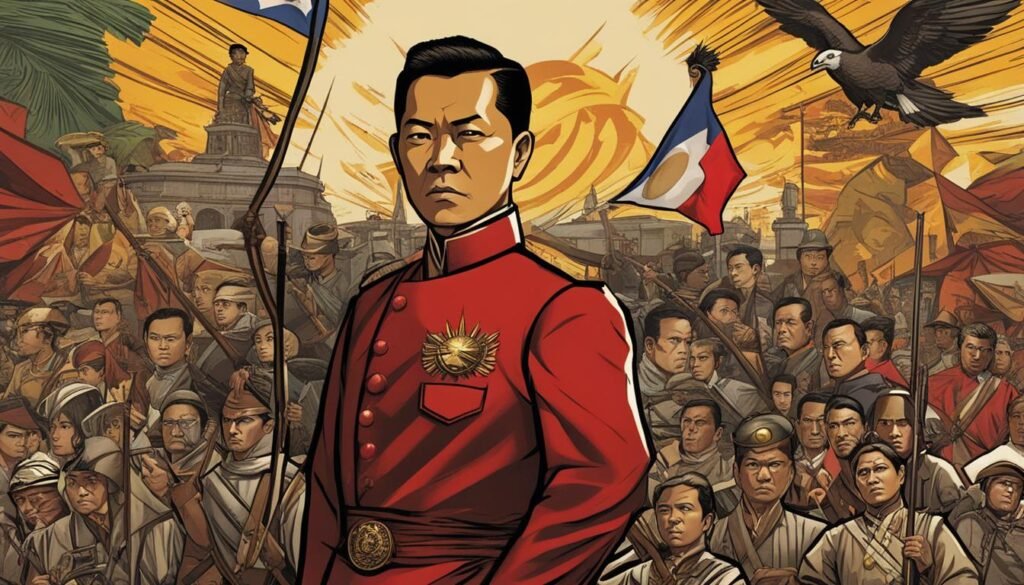
Years of Political Silence
Following the tumultuous years of the Philippine-American War and his capture by American forces, Emilio Aguinaldo chose to keep a low profile in the political arena. This period of political silence allowed him to reflect on the events that transpired and strategize for the future.
A New Role During the Commonwealth Era
Aguinaldo’s return to the political spotlight came during the Commonwealth Era under President Elpidio Quirino. He was appointed as a member of the Council of State, showcasing his enduring influence and relevance to Philippine politics. In this role, Aguinaldo advocated for nationalism, democracy, and improved relations between the Philippines and the United States.
| Emilio Aguinaldo’s Political Involvement Post-War |
|---|
| Years of Political Silence |
| A New Role During the Commonwealth Era |
Controversies and the Shadows over Aguinaldo’s Legacy
Aguinaldo’s legacy is marred by controversies, including allegations of his involvement in the deaths of revolutionary leader Andrés Bonifacio and general Antonio Luna. There were also rivalries with other revolutionary factions, leading to internal conflicts.
Questionable Decisions and Rivalries
During the Philippine Revolution, Aguinaldo’s leadership was tainted by questionable decisions and rivalries with fellow revolutionaries. The most notable controversy involves the execution of Andrés Bonifacio, a prominent leader of the revolutionary movement. The circumstances surrounding Bonifacio’s death remain a topic of debate among historians.
Aguinaldo’s rivalry with General Antonio Luna also cast a shadow over his legacy. Luna was a brilliant military strategist who clashed with Aguinaldo over military matters. Luna’s untimely death further fueled speculation of Aguinaldo’s involvement.
Allegiances during World War II
During World War II, Aguinaldo’s reputation suffered further when he collaborated with the Japanese Empire during their occupation of the Philippines. This tarnished his image and raised doubts about his commitment to Philippine independence. Many viewed his alliance with the Japanese as a betrayal of the Filipino people and their aspirations for self-determination.
The Nationalist Movement and Aguinaldo’s Continuing Influence
Despite the controversies surrounding Aguinaldo, his role as a nationalist leader and his contributions to the fight for Philippine independence continue to influence the nationalist movement in the Philippines. His legacy remains a topic of discussion and debate among scholars and historians.
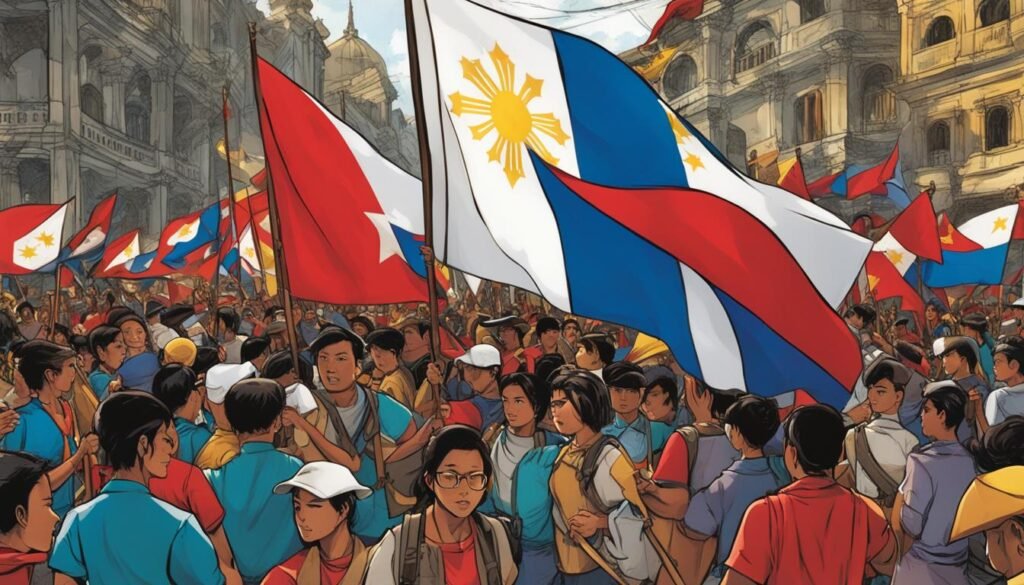
Aguinaldo’s steadfast commitment to the cause of Philippine independence has made him an enduring figure in the country’s nationalist movement. His leadership during the Philippine Revolution and his establishment of the First Philippine Republic paved the way for the aspirations of countless Filipinos.
Although his legacy is marred by controversies and complex historical narratives, there is no denying the lasting impact that Aguinaldo has had on the nationalist movement. His unwavering dedication to the fight for independence continues to inspire generations of Filipinos.
Aguinaldo’s Final Years and Death
In his final years, Emilio Aguinaldo focused on veterans’ affairs, advocating for the welfare and recognition of Filipino war veterans. He dedicated himself to the cause of promoting nationalism and democracy, striving to instill a sense of patriotism and civic responsibility among the Filipino people.
On February 6, 1964, Emilio Aguinaldo passed away in Quezon City, leaving behind a significant legacy. His contributions to the struggle for Philippine independence and his leadership during the early years of the First Philippine Republic had a profound impact on the nation’s history.
To commemorate his life and achievements, the Emilio Aguinaldo Shrine was established in Kawit, Cavite. This historical site serves as a memorial to honor Aguinaldo’s role as a pivotal figure in the fight for Philippine sovereignty. The shrine stands as a testament to his enduring legacy and contributes to preserving the memory of his contributions for future generations.
Emilio Aguinaldo: The National Hero and the Enigma
Emilio Aguinaldo is widely regarded as a national hero in the Philippines, recognized for his leadership in the fight for independence. However, his legacy is complex due to controversies and conflicting narratives surrounding his actions and decisions.
In recent years, there have been reevaluations of Aguinaldo’s place in history, with scholars and historians examining his role within the broader context of the Philippine Revolution and the struggle for independence.
Conclusion
Emilio Aguinaldo’s life and legacy are deeply intertwined with the history of the Philippines and its quest for independence. As the country’s first president, he played a pivotal role in shaping the early years of the nation.
However, Aguinaldo’s actions and decisions continue to be subjected to scrutiny. The complexities of his role as a national hero become apparent when considering the challenges faced during this tumultuous period in Philippine history. While he led the fight for independence and established the First Philippine Republic, controversies surrounding his leadership and alleged involvement in the deaths of prominent figures like Andrés Bonifacio and Antonio Luna have cast shadows over his legacy.
Despite these controversies, Emilio Aguinaldo’s contributions to the nationalist movement in the Philippines remain significant. His commitment to independence and his role as a revolutionary leader continue to inspire and influence the fight for national sovereignty.
As the Philippines continues to navigate its complex history, the legacy of Emilio Aguinaldo serves as a reminder of the challenges faced by the nation in its quest for independence. His life and presidency mark a critical chapter in Philippine history and prompt ongoing discussions and reevaluations of the country’s journey towards nationhood.
FAQ
When was Emilio Aguinaldo born?
Emilio Aguinaldo was born on March 22, 1869, in Cavite el Viejo, Cavite, Philippines.
What was Emilio Aguinaldo’s family background?
Emilio Aguinaldo came from a well-to-do family, with his father Carlos Aguinaldo serving as the gobernadorcillo (municipal governor) of their community.
Where did Emilio Aguinaldo receive his education?
Emilio Aguinaldo attended Colegio de San Juan de Letran but was unable to complete his studies due to a cholera outbreak in 1882.
How did Emilio Aguinaldo rise through the ranks of Katipunan?
Emilio Aguinaldo joined the secret society Katipunan in 1895 using the name Magdalo and quickly rose through the ranks to become a leader in the organization.
What role did the Freemasonry play in Emilio Aguinaldo’s fight for independence?
Aguinaldo joined the Freemasonry in 1895, which played a significant role in his fight for independence.
What tactics did Emilio Aguinaldo and his troops employ in their fight for independence?
Emilio Aguinaldo and his troops employed various tactics and strategies, including guerrilla warfare, in their fight for independence.
When was the First Philippine Republic established?
Emilio Aguinaldo declared the independence of the Philippines and established the First Philippine Republic on June 12, 1898.
What was the capital of the First Philippine Republic and who served as its president?
The capital of the First Philippine Republic was in Malolos, Bulacan, and Emilio Aguinaldo served as its president.
What constitution did Emilio Aguinaldo draft and adopt during his presidency?
Emilio Aguinaldo’s presidency was marked by the drafting and adoption of the Malolos Republic Constitution.
Who did the Philippines enter into conflict with during Emilio Aguinaldo’s presidency?
Despite their declaration of independence, the Philippines soon found themselves in conflict with the United States, leading to the outbreak of the Philippine-American War in 1899.
What agreement did Emilio Aguinaldo enter into following a series of military setbacks?
Following a series of military setbacks, Emilio Aguinaldo entered into the Pact of Biac-na-Bató, an agreement with the Spanish government that allowed him to go into exile in Hong Kong in exchange for financial compensation.
When did Emilio Aguinaldo return to the Philippines after his exile in Hong Kong?
Emilio Aguinaldo returned to the Philippines in 1898 and resumed his fight for independence.
What challenges did Emilio Aguinaldo face during his tenure?
Throughout his tenure, Emilio Aguinaldo faced numerous challenges and engaged in strategic battles to protect the sovereignty of the Philippines.
When was Emilio Aguinaldo captured by American forces?
In 1901, Emilio Aguinaldo was captured by American forces, marking a turning point in the Philippine resistance.
What role did Emilio Aguinaldo play during the Commonwealth Era?
During the Commonwealth Era, Emilio Aguinaldo served as a member of the Council of State appointed by President Elpidio Quirino and advocated for nationalism, democracy, and improved relations between the Philippines and the United States.
What controversies surround Emilio Aguinaldo’s legacy?
Emilio Aguinaldo’s legacy is marred by controversies, including allegations of his involvement in the deaths of revolutionary leader Andrés Bonifacio and general Antonio Luna, as well as rivalries with other revolutionary factions.
When did Emilio Aguinaldo pass away and where is he memorialized?
Emilio Aguinaldo passed away on February 6, 1964, in Quezon City. His legacy is memorialized at the Emilio Aguinaldo Shrine in Kawit, Cavite.
What is the reevaluation of Emilio Aguinaldo’s place in history?
In recent years, there have been reevaluations of Emilio Aguinaldo’s place in history, with scholars and historians examining his role within the broader context of the Philippine Revolution and the struggle for independence.
Source Links
- https://www.britannica.com/biography/Emilio-Aguinaldo
- https://en.wikipedia.org/wiki/Emilio_Aguinaldo
- https://guides.loc.gov/world-of-1898/emilio-aguinaldo-famy

